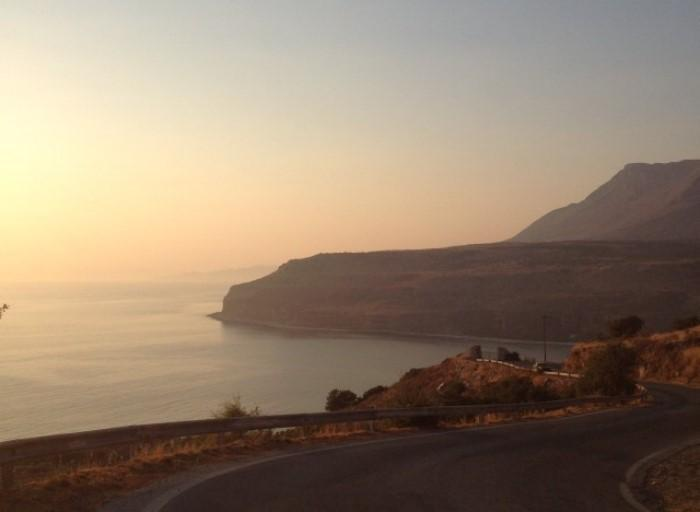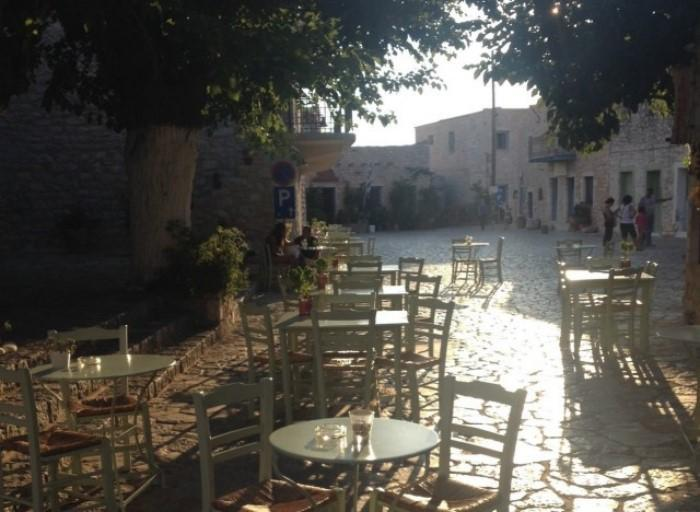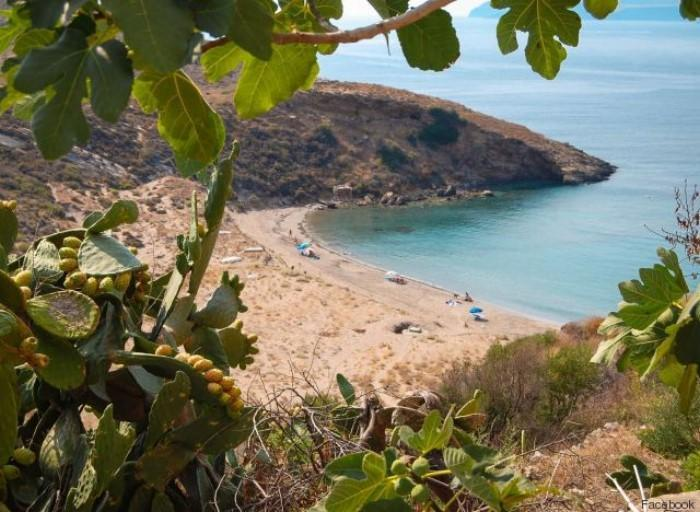The Laconian Mani, also known as the Inner Mani, stretches from Oitylo to Gythio and is home to a breathtaking collection of villages and several must-see landmarks that every traveler should visit in their lifetime.
Unlike the gentler, sweeter, and more familiar climate of Messinian Mani, both in terms of architecture and landscape, the Laconian Mani is marked by a captivating ruggedness: towering cliffs and winding roads hang over deep blue waters, silent towers stand grim on barren mountaintops overlooking the sea, picturesque villages of unparalleled beauty are nestled in small coves, where locals still recount tales of corsairs, pirates, and lost treasures. A relentless sun casts its rays over the stone that covers this land, lighting up everything in its path, yet burning it all at the same time.
Oitylo
Continuing from where we left off in Messinian Mani, the New Oitylo opens the door to Laconian Mani, a settlement that acts as a true guardian on the slope, with the castle of Kelevas standing proudly on the opposite hill. It offers a large beach with coarse pebbles, lined with various cafes, taverns, and rental accommodations — a popular destination for families with small children who prefer not to move much, as everything they need is conveniently gathered within easy reach.
Limeni
Immediately after, we reach Limeni, a coastal tower village and home of the Mavromichali family, small and enchanting with deep emerald waters, well-protected in the innermost part of the bay. You’ll find many charming spots for coffee, breakfast, or meals, but Limeni has long been associated with the famous "Taki" fish tavern, where you'll taste some of the best seafood you've ever had—though it's a good idea to make a reservation in advance and prepare for the high prices.
The Road from Limeni to Areopoli
After a 4km climb, we arrive at the City of Ares, the historic Areopoli, the heart of the liberation struggle. Here, the flame of the Greek Revolution was lit on March 17, 1821. Don’t be distracted by the gas stations and commercial shops at the city's entrance, or the somewhat indifferent central square. Park your car and take a stroll through the city's alleyways, starting from the central cobbled street that leads to the charming historical center, with its 30 preserved traditional buildings around the Church of the Archangels and the 17th March square.
Along the way, you'll discover lovely tavernas, patisseries, greengrocers, cafes, bars, and shops selling local products and folk art, and even some major clothing brands. Dining options include Barba-Petros (or Piero, as he's known), where you can taste exquisite home-cooked dishes and authentic Maniot recipes. Don’t miss the bread and savory pastries from the bakery in Milia, and for delicious ice cream made from fresh milk, stop at the "Traditional" dairy shop.
Areopoli
Let’s take a brief detour.
In Laconian Mani, you can also enter through Sparta. The other entrance is Gythio, a stunning town built amphitheatrically on the slopes of the Laconian Gulf, with old mansions, many of them in ruins but still majestic. The narrow alleys lead to the Monastery of All Saints, nestled in pine trees with views across the entire bay. Gythio also boasts a picturesque seaside promenade, especially beautiful at dusk when the lights of the waterfront hotels and craft shops gradually illuminate. It also features the small island of Kranae, said to have been the first romantic refuge of Paris and Helen after their escape from Troy, and the excellent lighthouse at its tip, surrounded by a small pine forest perfect for a stroll, with rocks ideal for diving.
Gythio
In Gythio, you'll find everything your heart desires: tavernas serving local cuisine, seafood restaurants with displays of fresh catches, cafes, bars, and shops. You’ll also start noticing the characteristic Maniot suffix “-akos,” which will follow you throughout the rest of your journey. In Messinian Mani, the “-ea” suffix predominates, with an old saying that only those with “-ea” in their name are true Maniots—though I’ve never been able to recall the rest of the rhyme!
Leaving Gythio, the road takes you past stunning beaches: the well-organized and popular Mavrovouni beach with its thick sand and quick-deepening waters, stretching over three kilometers. At the far end, about 300 meters up a dirt road, you’ll find a reliable little tavern serving braised rabbit with fried potatoes.
Vathy, Ageranos, Kamaras, Paganea: Hidden Beaches of Delight
Vathy’s camping site "Dias" offers a peaceful, clean, and friendly environment with very affordable prices, just a breath away from the shore—ideal for travelers who prefer simple, unpretentious accommodation. Kamaras has two lovely little tavernas reminiscent of forgotten corners from times past.
The Beach at Ambelos in Agios Kyprianos
Continuing along the coast, we come to Skoutari, with two beautiful beaches for those who want variety and three tavernas to choose from. The ancient church of Agia Barbara, nestled in laurel trees, is also worth a visit.
If you ever get tired of the sea (can you even imagine?), you can take a right turn and head up to Mount Taygetus.
Only a short distance—around 5 km—you’ll find Drosopigi, perched high above the Laconian Gulf, offering cool breezes and panoramic views. Enjoy a delicious meal or drink at the restaurant there, but don't overdo it with the drinks, as the return downhill can be quite winding.
Returning to Areopoli now, we reconnect with the route from Kalamata.
The state of the South is unique, just as every destination from here on out will be. Areopoli has a character that is hard to find anywhere else, just like Kardamyli in Messinian Mani.
Diros Caves
A little further along, a visit to the Diros Caves is a must—you've surely heard of them. After the tour, there’s a beautiful beach nearby where you can take a quick dip.
The road continues relentlessly toward Inner Mani.
Charouda, Charia, Dryalos, Vamvaka, Erimos, Stavri, Kitta, Kounos, Dry, Polemita, Mina, Triantafyllia, Kyparissos, Ochia, Alika, Tsikalias—small nests of towers atop hills, some high in the mountains, others in the valley. These are stone paintings, with a small church at every turn, each one centuries old. If you have the time, seek out the Panagia Agitri, a quick stop, but one that will stay in your memory forever. It’s built into the rock and overlooks the sea. It’s called "the Guide," and the locals have always appreciated its simple, unadorned beauty.
Mezapos
Continuing from there, make visiting Mezapos a priority. Take the right turn 1.8 kilometers in, and the first thing you’ll see ahead is the Frying Pan (Tigani). It closes the bay with its long, thin arm that ends in a round shape—it’s not named by chance. At night, it looks otherworldly when the moonlight sparkles on the water. As you descend to the sea, you’ll find yourself in a hollow surrounded by towering, eroded rocks, with yellow and brown stones carved into their surface. Prickly pear cacti grow on the peaks. It's a small anchorage where colorful wooden boats gently sway in the water's countless shades of blue.
Gerolimenas
Further down lies Gerolimenas, another ethereal beauty. A seaside gorge with a pebble beach, enclosed on the right by towering granite cliffs, and with houses built on the left. Once a bustling place for product transport, it now holds remnants of past commercial activity, visible in the rusted loading docks. As you walk along the street that runs through the houses, you’ll discover old carved signs from shops of another era. Today, there are several tavernas by the sea.
Vathia
Vathia is the ultimate tower village in the area. On a hill to the left of the road, its towers stand tall—once restored by EOT (Greek Tourism Organization) and famous worldwide as a travel destination. Like all beautiful things, the fairytale didn’t last long, and now the towers stand abandoned and in ruins, yet their uniqueness remains intact. Below, a beautiful fjord forms the area’s beach.
Porto Kagio
Porto Kagio, now and always, remains a welcoming, sheltered haven for quails migrating south. Here, they stop to rest before continuing their journey to the small harbor north of Taygetus. This is also the modern-day name for the ancient Psammathous or Psammathia: the port of quails, Port aux Cailles. Make a detour here, grab a coffee or try some fresh fish at one of the quiet tavernas.
Panoramic View from Vathia
Marmari is the only true sandy beach in Laconian Mani, shallow but always with impressive California-style waves. Generally, Marmari will captivate even the most demanding visitor, as, if you disregard the beachside rental accommodations, tavernas, and bars on one side of the beach, an incredibly wild and exotic landscape awaits, perfect for losing track of time.
Marmari
If you crave more isolation (though most visitors prefer sunbeds), just head 10 meters to the right of the main beach, and you’ll be essentially alone. Close to the main beach, there is a smaller one, easily accessible from the village, just a 10-minute walk from the hilltop.
Bring along a small cooler with water, fruit, and beers, set up your umbrella (camping is allowed here), and spend your entire day there—you won’t get bored for a second!
The "Second" Marmari
The "Second" Marmari
The road after Marmari leads to Taygetus, the end of the Old World. If you’re up for a two-kilometer hike (about 40 minutes), you’ll reach the famous and beautiful Lighthouse. Another trail will lead you to the Gates of Hades. From the edge of the world, travelers come to see the famous "Psychopomp" where the “postmen” would take the ferryman to the Underworld. It’s the very gate Hercules used when he brought Cerberus to Earth.
Taygetus
As you return from Taygetus and Marmari, heading back up the road from Porto Kagio, you won’t need to follow the same route. Head towards Lagia, one of the few Maniot villages that spreads out with walking neighborhoods and a lovely square where you can enjoy tsipouro with mouthwatering marinated anchovies—simply unbeatable.
























